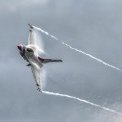Search the Community
Showing results for tags 'Helicopter'.
-
Today, Saturday, October 1st, 2022; I have finally started to build my MH-60G Pave Hawk II. The Kit is by Kitty Hawk and has been collecting dust in my basement until I could first build a dedicated studio and receive all the resin accessories i.e. figures, transmission, tail rotor assembly, mini-guns, .50 cal, and much more... Zorro
- 73 replies
-
Hi All, Diving head first into my first large scale model. In this case, it's Academy's lovely 1/35th scale AH-1Z Viper attack helicopter (I'm a dye-in-the-wool 1/72nd guy. Just ask @Greg W). I love the AH-1 series of helicopters, and really dig this particular variant (as well as the OG Vietnam War era AH-1G). I've picked up just about everything made for this model, so let's see if I can make it work. The box art; The aftermarket goodies; First thing to accomplish, and the most involved aspect as far as integrating an aftermarket set was preparing the forward fuselage for the Legend Productions AH-1Z avionics and ammunition bays. I drilled holes around the perimeter of the molded in bay access doors, then used a craft saw to removed the doors. Various sanding sticks and files were used to removed the remnants of the doors up to the door panel lines and clean up the opening. Here's the bays loosely fitted into place. I will permanently glue them into place once the bays are painted and the forward fuselage is assembled. Thanks to @Greg W for helping me get these fitted into place. His knowledge on how to tackle installing resin sets of this type was greatly appreciated. Here's the tail boom with some photoetch screens and Flying Leathernecks FMV antenna fairing fitted in place; Thanks for looking!
- 7 replies
-
- zulu
- helicopter
-
(and 2 more)
Tagged with:
-
Hello everyone. Some photos of my latest work. M-197 A/A49E-7(V4) gun turret system AH-1Z, Hydraulic-Helicopter-Ground-Handling-Wheels, Tow Tractor STT A/S32A-49.
- 14 replies
-
- helicopter
- cobra
-
(and 1 more)
Tagged with:
-
Ok guys, I'm in, in spite of my abysmally poor record at finishing anything since I joined LSP or participated in in any GB. The reasons I am joining are as follows: 1. Someone mentioned cookies 2. There will be cookies 3. Teresa's cookies are said to be without par 4. Why not have fun with eveyone else ? 5. Yeahh ! There will be cookies ! 6. It's a good opportunity to restore my modelling mojo, which has been flailing even more than before since my burn-out in october last year, 7. And finally, I have heard the word "cookies" ! I have chosen an unusual subject : a sled-dog that acted as St Bernard, but was named after a Mexican Chihuahua : Kaman's HH-43 Huskie, code-named "Pedro" (hence my title),. Introduced in october 1964 in Vietnam (well in Thailand really) for Air Rescue missions, it lasted there until well after the end of the war, the last Pedro detachment leaving Thailand in 1976, although it was progressively superseded by the tougher and faster UH-1. In spite of its speed and range limitations and initial lack of any armour, all of which made it a choice target for Vietnamese Forces during their perilous missions, the HH-43s are credited with more than 1 100 saves during the war, of which 888 (out of 2 039) during the 1966-1970 period, and achieved some records in availability and number of monthly missions flown. So all in all an important, if not glamorous, aircraft in this war, and an "esoteric" subject in line with my tastes. This one was represented in kit form, in 1/32, a few decades ago by Hawk, and can still be found on eBay for a few bucks, and is regularly reissued. A nice kit, simple, with some detail limitations, understandable given its age, but that can result in a nice model with some TLC. As some of you know, I am not keen on camoed aircrafts, and too-efficient killing machines. When I bought the kit off eBay, a few years ago, my grand plan was to finish it in a civilian livery of post-Air Force use. So this GB has had me change my plan, however not to the point of going for a camoed version. So I will go for a HH-43 B at Tan Son Nhut in 1965, where the Pedros were still painted aluminium with bright yellow rescue bands. Here is the compulsory pic of the box content. I will enhance the kit with some AM. Thanks to Kagnew, who helped me go round Cobra Company's self-imposed payment limitations, which make it very difficult for non North American residents to acquire these sets, I also acquired the detail set for the kit (now OOP I understand). However, liking detailing and scratchbuilding, I will not use the set, apart for some eventual inspiration, and do all teh corrections / detailing myself. The set is bookmarked for Karl (Blackbetty), with Bruce #2 in the queue. I will however use Airscale's intruments and bezels, and restore the visible rivets details (some of which will be lost in the cutting and fitting) using the HGW dry-transfer rivets' set. Finally, when finished (!), I will use SWS' nice PSP base. I have decided to not even check the shape and dimensions of the kit, and focus on detailing it. The tweaks' list I have worked out, and will complete as I progress includes already : - Detailed cockpit, new seats, new IP, new center console and upper console, food pedals and sticks ... - Detailed interior of the cabin - Have a go at representing the strssed skin affect that affected the rear fuselage; - Open-up the intake grilles and therefore include the oil-cooler details and a reasonable representation of the engine. Replace solid plastic grilles with suitable see-throuch ones - Represent the transmission cones, visible trough the side openings of the transmission-cowlings - Detail the landing gears and wheels - Detail the inside of the side-doors - Detail the rotors and their flaps system ... Ok. Now to the workbench ! Hubert.
- 13 replies
-
- Helicopter
- Huskie
-
(and 2 more)
Tagged with:
-
Now that the Tornado has been sent to the display shelves, I'm going in a different direction (for me anyway). I very rarely build helicopters, 2 Lynx built in 10 years, so I thought I'd give them some rotary winged company in the form of the above mentioned. To supplement the meagre part count in the box, I've added FlightPaths detail set which comes with a bunch of PE frets to augment the airframe details, and resin cast Hellfire missiles. I know next to nothing about the ins and out of this aircraft, so I can safely say that aside from the Flightpath stuff, this is being built from the box. I imagine that it's nowhere near an accurate representation of the type, nor do I desire to try and make it so. I simply wish to build the best looking version of what's in the box that I can. To that end, my main focus will be on the paint finish and heavy weathering associated with early years Desert Storm operational era. As I like to try and do with all my models, I intend to start with the weapons, I find I lose the mojo to finish a build off if I don't get them done before building the aircraft. Strap in, it's likely to be a bumpy ride with this fantastic death dealing machine.
- 33 replies
-
- revell 1/32
- apache
-
(and 2 more)
Tagged with:
-
1/18 scale Flettner Fl-282 V21 Kolibri 3D printed / scratchbuilt model After request, a 1/18 scale Fl-282 V6 helicopter with WWII Kriegsmarine markings built for a wealthy collector from Kiel, Germany. A second Luftwaffe’s Fl-282 V21 model followed for my own personal collection at home. Since the whole project cost (CAD design, 3D printing & model building) was entirely funded by the client, I did not hesitate to use the best available materials & machines to do the job. The text follows, is to describe the Flettner Fl-282 Kolibri (“B-0” series) helicopter as manufactured by Anton Flettner Flugzeugbau GmbH on early 1940ies, used by Kriegsmarine & Luftwaffe during WWII and scratch built by me as a 1/18 scale model, now days. Anton Flettner was a German aviation engineer & inventor who made important contributions on airplane & helicopter design. During the WWI, Anton Flettner developed remote control & pilotless aircraft projects, which culminated in the prototype Siemens Schuckert Werke 1000 kg wire guided air to surface missile of 1918. Following WWI, he directed aeronautical & hydrodynamic research institute in Amsterdam and during the WWII, he headed the Anton Flettner Flugzeugbau GmbH, which specialized in helicopters. It is believed that the firm was founded in Berlin in 1935. By this time, however, Flettner had developed the idea of counter-rotating, intermeshing twin rotors. Many of his advisers thought that the airflow disturbed by the intermeshing blades would make this system less efficient than one using a single rotor; but Flettner believed that any problems thus encountered would be more than offset by the reduced drag resulting from having no external rotor-carrying structure. His pioneer work is often overshadowed by the more publicised activities of his contemporaries Heinrich Karl Johann Focke and Igor Sikorsky; yet Flettner’s helicopter, was far superior to the Henrich Focke’s FW-61 and made a successful free flight several months before Igor Sikorsky’s VS-300 began tethered flights. Following pictures taken at Pfaffenwiesbach a district of the municipality Wehrheim, Germany. This artistic wall painting cultural monument, created by the local municipal council in memory of Anton Flettner who was the village teacher in Pfaffenwiesbach from 1906 to 1909. Although Anton Flettner built his helicopters for the German military, his wife Lydia Freudenberg Flettner was Jewish. Because of his personal friendship relationship with head of Gestapo, Heinrich Himmler, Anton Flettner’s Jewish wife and their family safely moved to Sweden for the duration of World War II. Anton Flettner’s partner and confidant was Dr. Kurt Hohenemser, a brilliant and thorough engineer who developed the details necessary for the helicopter’s success. Dr. Hohenemser's father was also Jewish, yet the pair remained unharmed during their tenure together throughout the War as they worked to develop the helicopter for military use. While the final product could be factory assembled, Anton Flettner and his partner Dr. Kurt Hohenemser insisted that they were the only ones who were capable of assembling the complex intermeshing rotor gearbox assembly. However, plans for 1000 helicopters mass production were made, the project was disrupted by the destruction of the designated factory by Allied bombing. In following pictures, Anton Flettner is proudly posing in front of his Fl-282s fleet at Schweidnitz (today Åšwidnica, Poland), on October 1944. The first helicopter is a V14 registered as CJ-SH. Upon the WWII conclusion, Anton Flettner was held in the “Dustbin†interrogation camp at Kransberg castle. After 1945, Flettner, along with many other aviation pioneers, was brought to the United States as part of Operation Paperclip. He started Flettner Aircraft Corporation, which developed helicopters for the US military. His company was not commercially successful, but his work was shared with the Army Air Corps. Many of his designs, such as intermeshing rotor concept, saw widespread use in a series of postwar helicopters built by Kaman for the US Navy and USAF. Anton Flettner moved to the United States in 1947 to work as a consultant to the Office of Naval research and became the chief designer of Kaman Aircraft, creating the Kaman HH-43 Huskie, a concept with intermeshing rotors. He died at age 76 in New York City, USA on December 29th, 1961 and buried in Eddersheim cemetery at Frankfurt, Germany where he was born. In following photograph, Anton Flettner (2nd from left) meets Wernher von Braun (3rd from left).
- 142 replies
-
I'm happy to see this group build actually taking off! So here's my contribution... Surprise its also a subject I have wanted to do for a very long time... One of Air Greenlands choppers, a Bell 212 Twin Huey. Why is it special to me? I Haven't been to Greenland - yet but many years ago I actually flew a couple of times with this chopper when it was still used by Maersk to ferry crews to oil rigs in the North Sea... This is what it looked like at that time... This is the kit I will be using... I have no idea as of what is needed to convert it into a civilian helicopter. I haven't done any research into it. So if you have any knowledge, you are welcome to share it with me... To me, Greenland is a very special place with a spectacular nature and since it used to be part of the Kingdom, we are sharing a lot of history with it here in Denmark... Ready to take a trip to the Greenland ice cap...
-
If you haven't seen Alexander Rogals outstanding OH-58D build you should definitely check it out: http://www.arcforums.com/forums/air/index.php?showtopic=227564 Many of those parts are now available (as well as a few that I made) with a bunch of photo-etch details: More details and some better pics can be seen in the ZactoForum: http://www.arcforums.com/forums/air/index.php?showtopic=233605 Already ordered the MMS and want the rest? E-mail for details. Zactoman@Zactomodels.com The set is available at http://zactomodels.com/ Cheers! Chris
-
1/18 scale Bolkow Bo-102 Helitrainer scratchbuilt model The Bölkow Bö-102 Helitrainer was an unusual ground-based helicopter training aid that was developed and built by Bölkow of Germany in the late 1950ies. It embodied all essential elements of a conventional helicopter, but was mounted on an articulated gantry to allow a student controlled experience of helicopter systems. Designed to be mounted on a swivelling captive rig the Bölkow Bö-102 Helitrainer allowed trainee pilots to practice procedures such as engine starting, rotor engagement and manipulation of the flight controls. Many of the Bö-102's components, including the single bladed fiberglass main rotor were used in the company's next design, the Bölkow Bö-103. Looks like a kiddie heliride, a toy for big boys huh? Rolled out in 1957, this Helitrainer was powered by a Hirth 3-cylinder / 2-stroke 40hp ILO L3X375 piston engine rated at 30 kW, driving a simple 21 foot one-bladed fiberglass rotor with a counterweight. In all 18 of these Helitrainers were built operating throughout Europe, training military helicopter pilots. Although unable to fly, they were ideal for the teaching of hovering techniques and were replaced by dual trainer helicopters. The Bölkow Bö-102 Helitrainer offered a variety of advantages for a safe helicopter training and was developed in land and water based versions, both of which were semi-captive. The first training section was conducted on this model mounted on a boogie. It facilitated the training of starting, tuning the rotary speed, taking off, hovering, turning, and landing. Simple exercising device for beginners’ training. Safety risk minimized by captivation, yet limited flight maneuvers possible. This feature allowed the helicopter to rise to a height of 2m (6ft), turn around a vertical axis and dip at up to 6° but prevented it from flying outside these limits.
- 67 replies
-
- helitrainer
- 3d printed
-
(and 6 more)
Tagged with:








